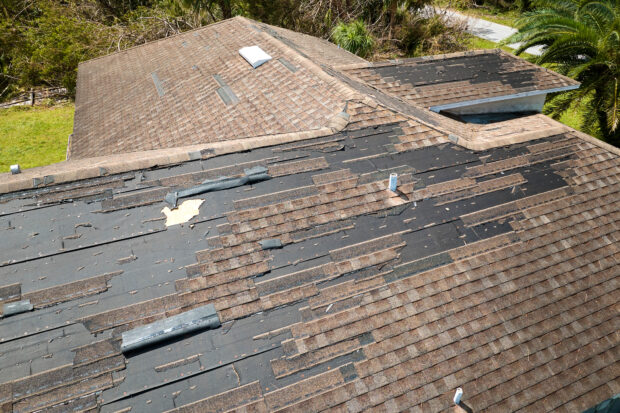Rate hikes haven’t been enough to bring profits to U.S. homeowners insurers, according to a new analysis from Aon, which finds that returns-on-equity for a group of homeowners insurers studied are negative in more than half of U.S. states.
The negative prospective returns were calculated by Aon for single-state specialists in a new report, “Homeowners Return on Equity Outlook–October 2024 report.”
National writers with more geographically diversified books aren’t doing much better. The report estimates a prospective ROE for eight diversified homeowners insurance carriers at 5 percent, down from 6 percent in last year’s report.
The results for the two cohorts come in spite of the fact that from January 2023 through June 2024, carriers have filed and regulators have approved double-digit premium rate hikes in almost every state—the largest average rate increases since 2015.
Why haven’t rate increases been enough to lower combined ratios and boost ROEs?
The report suggests that aging asphalt roof shingles, which aren’t holding up to damaging winds of severe convective storms, are key factors denting carrier profits. The report proposes non-rate policy fixes like creative roof deductible strategies.
Aon expects “insurers will earn meager ROEs insufficient to support the underlying risk,” said Paul Eaton, head of U.S. Actuarial of Aon’s Strategy and Technology Group, offering a key conclusion from a report that not only sets forth estimated likely ROEs projected by Aon’s actuaries but also summarizes reported historical results achieved across the industry over the last one-, three-, five- and 10-year periods.
The reported results for 300 insurance groups reveal that the industry hasn’t posted an aggregate homeowners insurance underwriting profit since 2019 when the reported industry combined ratio was 99. For every year since 2019, the reported homeowners industry combined ratio was at least 105.
“Even with investment gains it is unlikely many insurers reported positive pre-tax income for writing homeowners policies.”
“Even with investment gains it is unlikely many insurers reported positive pre-tax income for writing homeowners policies,” the report states.
According to Aon, in four of the last five years, insurers failed to earn any profit at all. And in all five, insurers underperformed Aon’s actuarial estimates.
Aon calculated actuarial estimates of “prospective ROEs” for the homeowners line of insurance starting with direct losses, expenses, payout patterns and investment yields reported on statutory filings, bringing premiums to current rate levels and replacing actual historical catastrophe losses with modeled losses developed by Aon’s Impact Forecasting, among other adjustments. (See sidebar, “Return on Equity Study Methodology”)
The profit outlook for the nation’s homeowners insurers is bleak, based on Aon’s analysis of both historical and prospective results. At prospective 2024 rates, homeowners insurers will end up with only one penny of profit for every premium dollar they earn on a direct basis—before taxes and reinsurance costs—a single cent that must be shared between the primary carrier, reinsurance partners, and the U.S. Treasury, the report states.
Slim to non-existent underwriting profits, translating into negative and single-digit historical and prospective ROEs have another implication: Capital will not be attracted into the homeowners business, the report says, noting that investors expect a double-digit return on their capital to support volatile catastrophe-exposed lines.
In fact, based on the experiences of Aon’s Capital Advisory Group, which has worked with potential startup clients with business plans centered around home insurance, investors return requirements can exceed 20 percent.
Fixing Roof Coverage
After setting forth a review of aggregate reported results over the last decade, and before mapping out actuarial estimates of November 2024 prospective ROEs at current rate levels, the Aon report summarizes key insights about the vulnerability of asphalt shingle coverings taken from a July 2023 study by the Institute for Business & Home Safety.
Among the findings:
- A severe convective storm with wind speeds over 100 mph will almost completely destroy a 10-year-old roof.
- At eight years old, there is a 25 percent chance that a roof will sustain at least some damage from any SCS event.
- Between 10 and 15 years old, the probability that an SCS event will damage at least half of the roof jumps from 0 to 50 percent.
- Nearly three-quarters of single-family homes in the U.S. have an asphalt shingle roof covering.
With that information as background, Aon turned from the question of whether homeowners insurers can earn a profit to a question about roof coverage: “Are roofs insurable?”
Maybe not with guaranteed replacement cost coverage, the report seems to suggest, stating that roof depreciation “may be an area to address high insurance utilization rates following SCS events.”
In addition, insurers should rethink “flat line depreciation over 30 years, considering that IBHS studies reveal roof life expectancies shorter than 20 years and protection levels that drop off in a non-linear fashion.
Aon also highlights coverage expansion that has happened as deductibles shrink relative to policy limits, suggesting insurers structure policies with different (percentage) deductibles or loss sharing (copays) for roof damage losses.
Reported Results
“Most homeowners insurers lost money over the last decade and the number of insurers losing money is increasing,” the Aon report states in a section summarizing the historical homeowners underwriting results for 300 insurance groups. Displaying the results graphically with bars indicating the number of groups achieving different levels of profit and loss for one-year, three-year, five-year and 10-year periods, Aon shows that over 100 groups had underwriting losses of 10 percent (of earned premium) or more over the entire decade, and more than half reported a similar level of underwriting losses for the one-, three-, and five year periods.
Other takeaways:
- More than 200 of the 300 total failed to earn any underwriting profit in most periods at all.
- Only about 50 of the 100 insurers that earned an underwriting profit managed to earn a 10 percent ROE when investment gains were added.
- One-year results are almost universally worse than three-year results and both are mostly worse than five-year and ten-year results.
Actuarial Projections: ROEs at Current Rates
Aon’s analysis of ROEs at current rates for a “national cohort” of eight top U.S. homeowners and a “synthetic” cohort of single state specialists is summarized on maps of the U.S. illustrating state-by-state ROEs, combined ratios, and combined ratios required to achieve a 10 percent ROE. Among the highlights, the maps reveal:
- The prospective countrywide combined ratio for the national cohort is 96, which yields a 5 percent ROE.
- For the single-specialists, the countrywide combined ratio is three points higher, at 99, and ROEs are negative in roughly 30 of the 50 states.
- States where single-state specialists have negative ROEs include a big swath of the Midwest and California, while the ROE for Florida is in the 7-9 percent range for the specialist cohort.
- For national writers, positive ROEs are shown for the Midwest states, while Aon calculates negative ROEs for these carriers in Southeast states other than Florida.
- In Florida, national writer ROEs have reached double-digits and national writers are underweight in Florida market share relative to the rest of the country.
- Calculated prospective ROEs at current rates for national writers fall in the 0-3 percent range in California.
- In order to achieve a 10 percent ROE, a diversified national writer must write at an average countrywide combined ratio of 91—5 points below the calculated prospective combined ratio—with combined ratios of 86 and 88 in peak catastrophe states of Texas and New York.
- Single-state writers need combined ratios in the low-80s to reach the 10 percent ROE hurdle.
Overall, according to the text of the report, specialists have generally tended to be proactive in filing higher rates when compared to the national cohort but over the past two years, the national and specialist cohort saw nearly identical average rate changes of 11 points in 2023 and 13 in 2024.
To hit the 10 percent ROE target, Aon estimates that specialists need more rate in just about every state—and additional rate jumps of 15 percent or more in roughly two-third of all states, including most of the middle of the country.
In contrast, for the national cohort, only a handful of Southeast states (other than Florida) need hikes of that magnitude, while rates adequate for achieving 10 percent ROEs are in place in Florida and 10 other states.
“We view profitability as a way that our industry can continue to serve [its] social purpose” of helping people recover from fortuitous financial losses, Aon stated at one point in the report where the authors set forth a list of recommended risk and accumulation management activities for insurers beyond pricing actions.





















 The Future of Knowledge in Insurance: From Training to AI-Powered Productivity
The Future of Knowledge in Insurance: From Training to AI-Powered Productivity  Executives on the Move at HSB, American Modern Insurance Group, AIG
Executives on the Move at HSB, American Modern Insurance Group, AIG  A Practical Blueprint: The Five Plays of an Innovation Culture
A Practical Blueprint: The Five Plays of an Innovation Culture  Unpacking a Consumer Intervenor’s Novel Idea
Unpacking a Consumer Intervenor’s Novel Idea 





